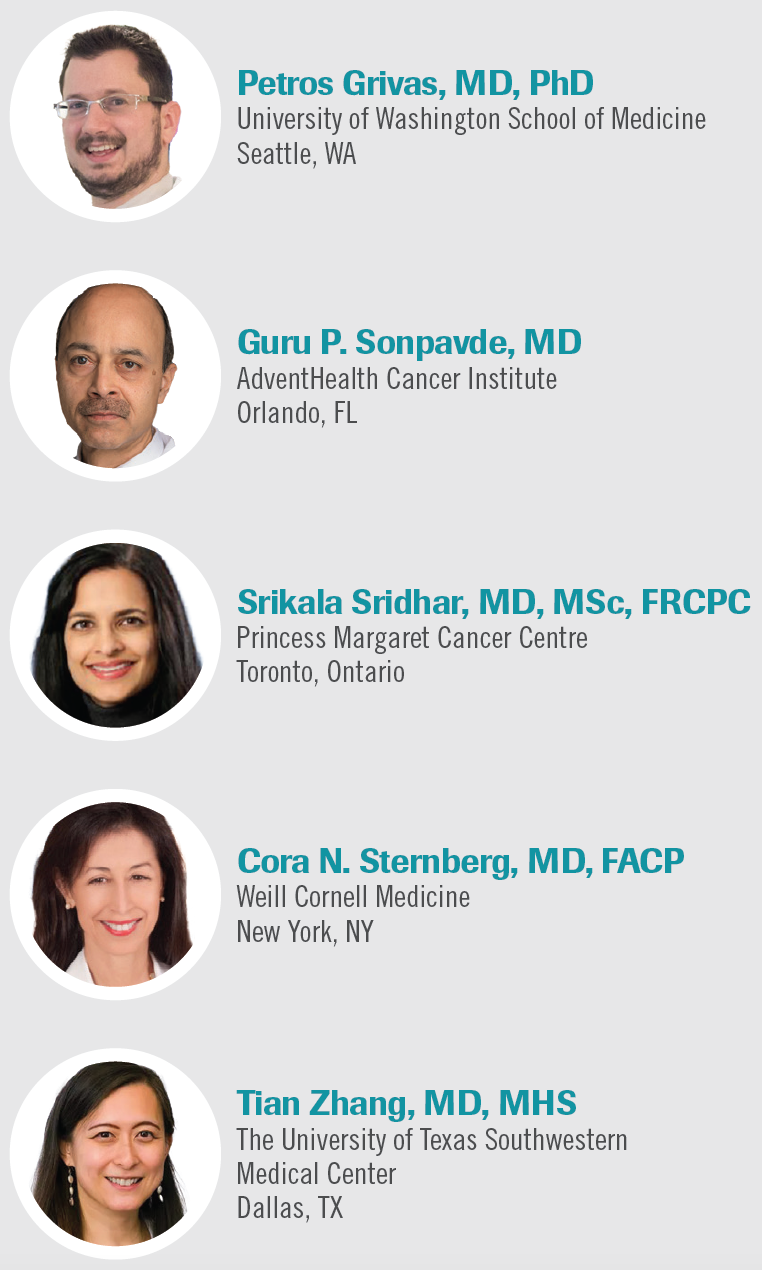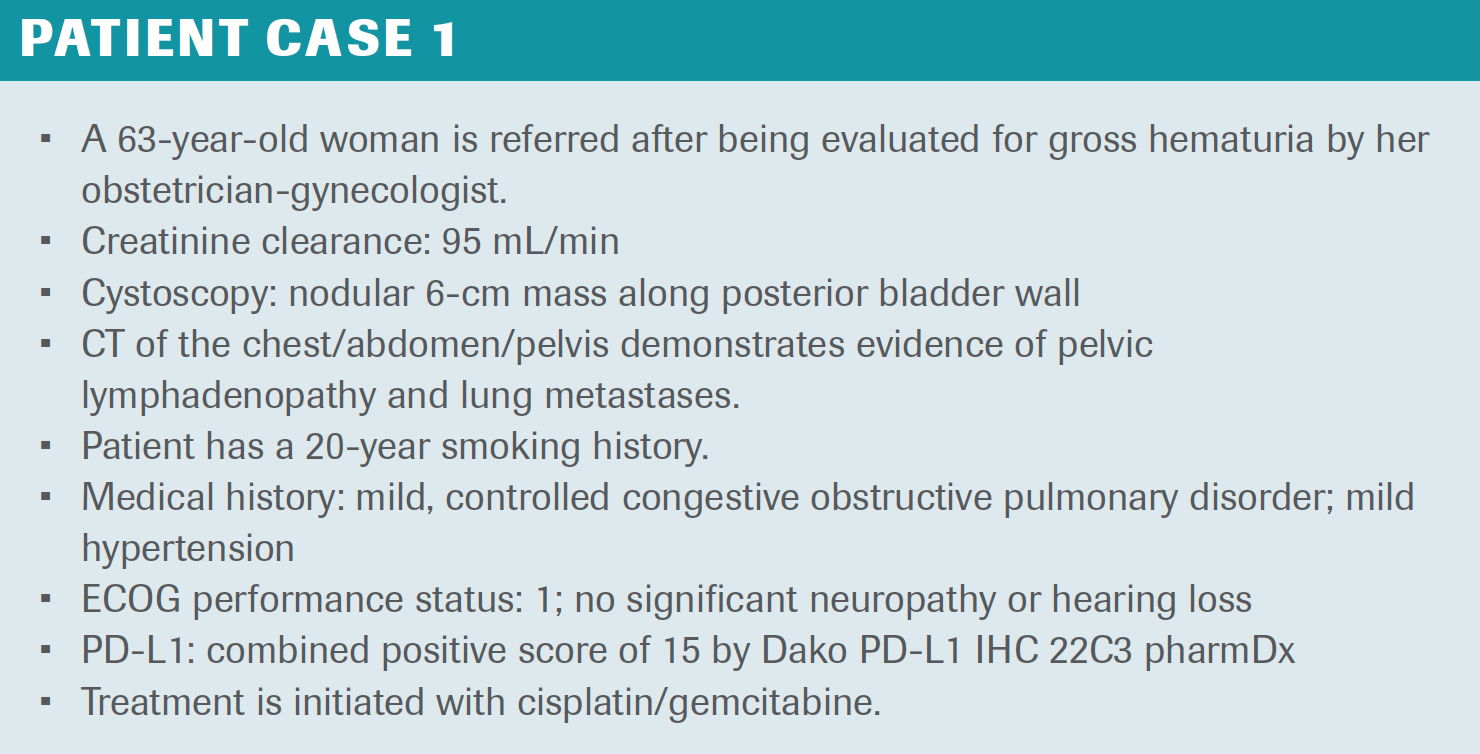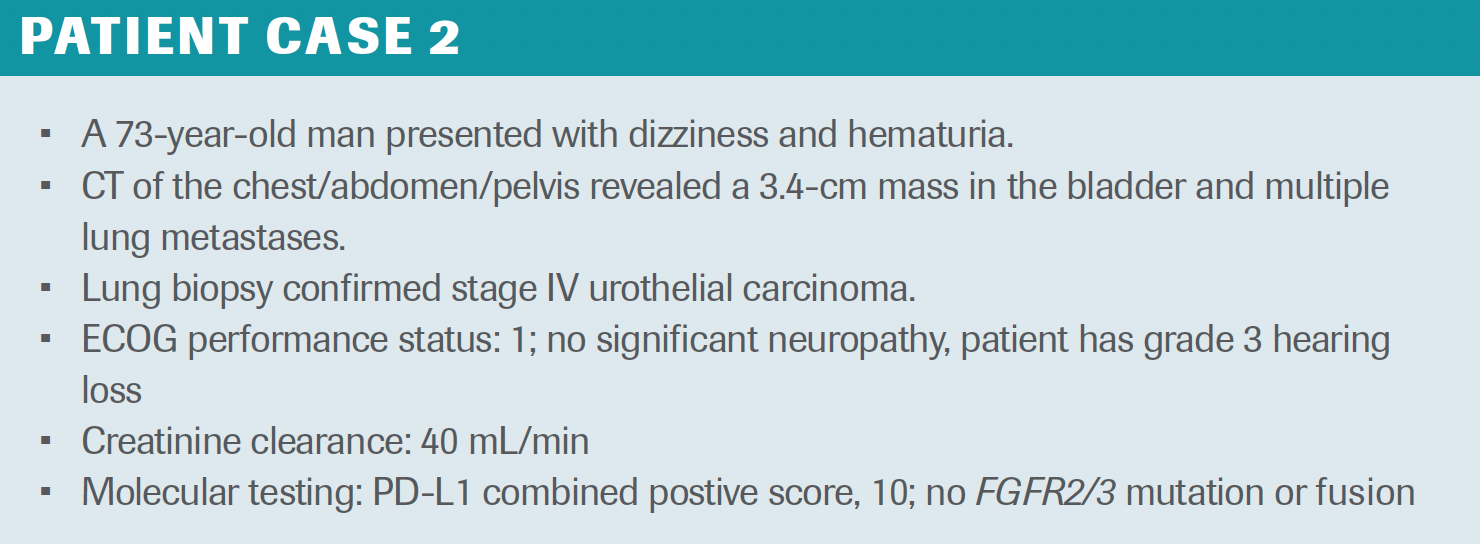Recap: The Expanding Treatment Paradigm for Urothelial Carcinoma
Centering discussion on clinical scenarios of urothelial carcinoma, expert oncologists review recent data and discuss how patient care is evolving.

At an Around the Practice® program hosted by CancerNetwork®, experts spoke about the current treatment paradigms in urothelial carcinoma. The discussion was led by Petros Grivas, MD, PhD, clinical director of the Genitourinary Cancers Program and professor in both the Division of Medical Oncology at the University of Washington School of Medicine and Clinical Research Division at the Fred Hutchinson Cancer Research Center in Seattle.
Panelists included Guru P. Sonpavde, MD, director of genitourinary oncology and Christopher K. Glanz Chair for Bladder Cancer Research at the AdventHealth Cancer Institute in Orlando, Florida; Srikala Sridhar, MD, MSc, FRCPC, professor in the Department of Medicine at the University of Toronto and a genitourinary medical oncologist at the Princess Margaret Cancer Center in Toronto, Ontario; Cora N. Sternberg, MD, FACP, professor of medicine and clinical director of the Englander Institute for Precision Medicine at Weill Cornell Medicine in New York, New York; and Tian Zhang, MD, MHS, associate professor in the Department of Internal Medicine at The University of Texas Southwestern Medical Center in Dallas.
Understanding Treatment Paradigms in Urothelial Carcinoma
GRIVAS: What are the guideline-approved therapies for metastatic or advanced urothelial cancer?
ZHANG: Our first-line treatments for metastatic urothelial cancer are still based on chemotherapy. Many of the regimens are cisplatin based. We use either cisplatin with gemcitabine or the 4-drug regimen, MVAC [methotrexate, vinblastine sulfate, doxorubicin, and cisplatin], for active patients with good prognoses and performance statuses. The JAVELIN Bladder 100 trial [NCT02603432] showed that we should use maintenance avelumab [Bavencio] for patients who have at least stable disease or better after chemotherapy.1
In the second line, we use immunotherapy regimens—mostly PD-1 or PD-L1 inhibitors—with pembrolizumab [Keytruda] or atezolizumab [Tecentriq]. For patients who are refractory to both chemotherapy and immunotherapy regimens, we have other options. [For example], there is a class of antibody-drug conjugates, including enfortumab vedotin [Padcev] and sacituzumab govitecan [Trodelvy]. We now have erdafitinib [Balversa] for patients with FGFR alterations.
Overall, we’ve come a long way in the past 5 to 7 years in the treatment of metastatic urothelial cancer, and guidelines keep evolving. New trials and new data [are continually creating] new options.
GRIVAS: How will new data evolve treatment in the frontline setting?
SONPAVDE: The standard in the frontline setting for most patients was established in the JAVELIN Bladder 100 trial and consists of 4 to 6 cycles of platinum-based chemotherapy followed by maintenance avelumab in patients with stable or responding disease.
However, the most exciting new data concern enfortumab vedotin with pembrolizumab. Enfortumab vedotin, the antibody-drug conjugate targeting NECTIN4 with the [monomethyl auristatin E] toxin, has looked very promising when combined with pembrolizumab in 2 studies so far. In the first-line cisplatin-ineligible advanced urothelial cancer space, enfortumab vedotin with pembrolizumab showed a 73% response rate in a 45-patient phase 1b study.2 Additionally, we now have [data from] cohort K of the randomized phase 2 EV-103 trial [NCT03288545], in which the combination of enfortumab vedotin with pembrolizumab seemed to show activity consistent with prior data, [resulting in] a 64.5% response rate.3 The control arm [of enfortumab vedotin alone] also had a robust response rate of approximately 45%, [which is similar to] what was seen before in the second-and third-line spaces. [For this reason], enfortumab vedotin with pembrolizumab looks very interesting in the cisplatin-ineligible space.
Of course, the definitive study will be the phase 3 EV-302 trial [NCT04223856] comparing gemcitabine plus cisplatin with enfortumab vedotin plus pembrolizumab in cisplatin-eligible and -ineligible patients. [Notably], that trial includes [patients treated with] maintenance avelumab in the control arm.
The other trial to watch is CheckMate901 [NCT03036098], which recently [yielded negative results, showing that] ipilimumab [Yervoy] plus nivolumab [Opdivo] could not outperform gemcitabine plus platinum chemotherapy in patients with high PD-L1 expression, regardless of a cisplatin or carboplatin backbone.4 We’re still waiting for the results of the comparison between gemcitabine/carboplatin vs ipilimumab plus nivolumab in cisplatin-ineligible patients regardless of PD-L1 status. There’s also an interesting substudy comparing gemcitabine/cisplatin vs gemcitabine and cisplatin plus nivolumab. This is a well-powered comparison in the cisplatin cohort only. And as you might remember from the KEYNOTE-361 [NCT02853305] and IMvigor130 trials [NCT02807636], the combination of atezolizumab or pembrolizumab with platinum-based chemotherapy looked more promising with a cisplatin backbone.5,6 We need to watch this trial because that could also be an option in the first-line treatment setting.
GRIVAS: If enfortumab vedotin plus pembrolizumab receives accelerated approval from the FDA, would you stick with the platinum chemotherapy plus avelumab maintenance standard of care and wait for more data from EV-302? Or would you begin using enfortumab vedotin with pembrolizumab?
SONPAVDE: I would discuss the data with patients. JAVELIN Bladder 100 included long-term follow-up, and it’s a phase 3 trial showing improved survival. But of course, it’s applicable only to patients with stable or responding disease following platinum-based chemotherapy. Enfortumab vedotin plus pembrolizumab, on the other hand, seemed very robust in the cisplatin-ineligible patient group.2 A [treatment resulting in a high response rate is attractive] when dealing with patients who are highly symptomatic and whose disease you want to control quickly. [Of course], enfortumab vedotin plus pembrolizumab may not be for everyone, [such as] patients with neuropathy at baseline. However, if you want to control symptomatic disease, enfortumab vedotin plus pembrolizumab may be a very active regimen.
SRIDHAR: Ultimately, I prefer to wait for the data from the EV-302 study, as my country requires. [The data regarding] enfortumab vedotin plus pembrolizumab is encouraging and exciting, and the response rates with that combination are starting to challenge those seen with cisplatin, [which is something] we haven’t really seen before. It will also be important to examine which patients are considered cisplatin ineligible and which are not, [as well as] where the line is drawn—because if you have a new treatment option, that [line] could change.
STERNBERG: A patient of mine with a creatinine clearance of 30 mL/min and widely metastatic disease was treated with enfortumab vedotin plus pembrolizumab, and he’s now completely disease free. The regimen was therefore highly effective in a patient with very low creatinine clearance, which is interesting.
[However], the main problem I have with enfortumab vedotin plus pembrolizumab is that all my patients eventually seem to develop neuropathy. It’s therefore impossible to give this treatment indefinitely. It seems at least as difficult [to tolerate] as cisplatin, or maybe worse, as far as I’m concerned. [For this reason], I prefer to see cutoff at some point, or continue with just the pembrolizumab or something similar.
ZHANG: Enfortumab vedotin with pembrolizumab has such high response rates, and it’s the first combination to really challenge chemotherapy in the up-front setting for metastatic disease.
[To speak on] cisplatin eligibility criteria, we often think about the Galsky criteria, a combination of renal function and performance status [that allows] neuropathy and hearing loss to come into play. [This is useful] when deciding which patients can handle cisplatin. We often find overlap between cisplatin-eligible and cisplatin-ineligible populations, so I’m interested to see the data from cohort K to help figure out the right candidates.3
The EV-302 study comparing enfortumab vedotin plus pembrolizumab [with] chemotherapy will set the benchmark for broader ranges of populations.
GRIVAS: Do we feel deescalation studies down the road might support shrinking the duration of chemotherapy or enfortumab vedotin?
STERNBERG: There are interesting deescalation trials, even with avelumab, [examining the efficacy of] reducing cycles of gemcitabine and platinum-based chemotherapy. [For example], the DISCUS trial [ISRCTN15750433] is comparing 3 vs 6 treatment cycles [of chemotherapy before avelumab in this setting].
Also [regarding maintenance, we’ve only ever] studied 2 years of pembrolizumab and indefinite avelumab. We should consider deescalation of these, as well.
Deescalation studies in all tumors should be [thoroughly] considered. We always assume we should give as much therapy as we can, the biggest combinations possible, and the most treatment up front as possible, but I don’t know whether this is always best for our patients.
GRIVAS: Could we briefly summarize the JAVELIN Bladder 100 trial?
SRIDHAR: JAVELIN Bladder 100 examined approximately 700 patients randomly assigned 1:1 to receive either avelumab or best supportive care [in the maintenance setting following frontline platinum-based chemotherapy]. The avelumab was given at a dose of 10 mg/kg every 2 weeks. As we mentioned earlier, patients were only included if they [were treated previously] with either gemcitabine and either cisplatin or carboplatin. They were required to have undergone 4 to 6 treatment cycles and shown some disease control, either stable disease, partial response, or complete response.1
The randomization occurred after a treatment-free interval of 4 to 10 weeks. The primary end point was overall survival [OS] in both the intention-to-treat population and the PD-L1–high population. The results showed an OS of approximately 21 months with avelumab vs approximately 14 months with best supportive care, which is roughly a 6-month improvement.1 [This was] probably one of the first large phase 3 studies in the frontline setting [to show positive results].
GRIVAS: Do you use anything aside from avelumab?
SONPAVDE: I stick with avelumab because of those data from JAVELIN Bladder 100 showing an improvement in survival. There was a smaller, randomized phase 2 trial [NCT02500121] of the checkpoint inhibitor pembrolizumab [as maintenance], which examined approximately 50 patients in each arm. The primary end point was PFS [progression-free survival], which was prolonged with pembrolizumab.7 However, this was a phase 2 trial and not powered for survival, so I don’t consider those data standard in the switch-maintenance setting.
GRIVAS: Can you briefly comment on the new data from the ATLANTIS trial [ISRCTN25859465] on maintenance with niraparib [Zejula] and cabozantinib [Cabometyx]?
SONPAVDE: The ATLANTIS trial is a randomized phase 2 platform trial in the United Kingdom for the switch-maintenance setting examining patients with stable or responding disease after platinum-based chemotherapy. Additionally, within each molecular cohort, there was further randomization to placebo. There was an arm including [patients with] DNA damage repair [DDR] alterations in which niraparib was compared with placebo, and another arm of patients without alterations. They [also examined] cabozantinib vs placebo. [Lastly], there’s an unreported third cohort examining enzalutamide [Xtandi] in patients with androgen receptor and DNA damage alterations. Two of these arms have reported results: the cabozantinib arm and the niraparib arm.
Cabozantinib showed negative results, but [this may have been a consequence of] some negative selection because we don’t know whether patients with DDR alterations are at higher risk.8
Additionally, although niraparib was promising, there wasn’t a good separation of the PFS curves, which was the primary end point.9 This was a well-selected population. We need more data—ideally from a definitive phase 3 trial.

GRIVAS: Would you do anything differently, or would you continue with the described treatment?
STERNBERG: With a younger patient in good shape, I would still use MVAC because it’s stronger than gemcitabine/ cisplatin. I see better results with this old-school [treatment]. I do sometimes use gemcitabine/cisplatin, and if the patients are older or have poor creatinine clearance, I will even give them split-dose gemcitabine/cisplatin.
GRIVAS: If you see response or stable disease after 6 cycles on gemcitabine/ cisplatin or gemcitabine/cabozantinib, how long do you wait to start avelumab maintenance?
SRIDHAR: That’s a great question. In the study, they examined the treatment-free interval with avelumab. They looked for differences between treatment start points, ranging from 4 to 10 weeks, and didn’t find many. It becomes a discussion with the patient to individualize when they want to start treatment with avelumab. Sometimes they prefer to take a break after chemotherapy, and the data allow that. On average, most of my patients start around 6 weeks after the end of chemotherapy. They finish, recover from the adverse effects, then are ready to get started.
GRIVAS: Looking at these data, do you follow the guideline to continue with avelumab until progression or toxicity? How do you move forward with treatment?
ZHANG: I do usually treat until progression or unacceptable toxicities. Some patients tend to do very well, so they can sustain treatment for several years. Now at the 2- or 3-year mark, they will sometimes ask whether they can discontinue treatment, and we’ll discuss that. There are not any good prospective discontinuation data, which is certainly something we need. However, it’s reasonable to discontinue if the patient has had an excellent response and wants to stop after 2 years.
GRIVAS: What were the results of the PRESERVE3 trial [NCT04887831]?
SONPAVDE: The PRESERVE3 trial builds on the JAVELIN Bladder 100 paradigm. This is a randomized phase 2 trial examining platinum-based chemotherapy followed by avelumab maintenance with and without trilaciclib [Cosela], which is an intravenous CDK4/6 inhibitor. It’s approved for patients with small cell lung cancer in combination with platinum/ etoposide chemotherapy to prevent myelosuppressive complications10 and has also shown an interesting survival signal in triple-negative breast cancer.11 The investigators therefore wanted to examine trilaciclib in urothelial carcinoma, because in that space, we have a chance to improve the immune state with avelumab. Data showed trilaciclib can also enhance the patient’s immune state and protect their immune cells by putting them in hematopoietic cell arrest after division. Therefore, trilaciclib could protect the immune cells from chemotherapy and the myeloid cells from the chemotherapy-induced myelotoxicity.

GRIVAS: How should this patient be managed?
STERNBERG: This patient has a creatinine clearance of 40 mL/min and hearing loss—at least 2 reasons he would be cisplatin ineligible. For me, this patient has 2 options. [First], he can start with gemcitabine and carboplatin followed by avelumab maintenance. If you think he cannot tolerate chemotherapy, the other option would be to give him immunotherapy with either pembrolizumab or atezolizumab up front. He’s not eligible for erdafitinib because he doesn’t have an FGFR mutation.
GRIVAS: Would that change if the patient did have an FGFR mutation?
STERNBERG: I wouldn’t give erdafitinib in the frontline setting in any case.
GRIVAS: Would you still give maintenance avelumab regardless of the up-front treatment?
SRIDHAR: Absolutely. JAVELIN Bladder 100 allows us to give maintenance avelumab regardless of chemotherapy regimen, the number of between 4 to 6 and of PD-L1 status. We can begin treatment with avelumab at any time within that treatment-free interval.
GRIVAS: How would you treat a patient who performs very well but then progresses 10 months later on maintenance avelumab?
SONPAVDE: If the patient has an FGFR alteration, erdafitinib and enfortumab vedotin are 2 options. Sacituzumab govitecan is also available for select patients who might not tolerate enfortumab vedotin or erdafitinib.
If the patient doesn’t have an FGFR3 activating mutation or an FGFR2 fusion mutation, erdafitinib is not an option, and enfortumab vedotin is the only drug with phase 3 evidence. However, [other options include] sacituzumab govitecan and docetaxel. Anecdotally, later-line docetaxel does show some activity even after failed treatments with these other drugs.
GRIVAS: If a patient with an FGFR3 mutation progresses on avelumab 10 months later, would erdafitinib or enfortumab work best?
STERNBERG: There are not enough data. Some small studies have suggested treating with erdafitinib first might be better, but [the sample size was small]. I might treat with erdafitinib first, then move on to enfortumab vedotin, but it’s not based on any large study.
GRIVAS: Will toxicity profiles and methods of delivery affect this decision?
ZHANG: Sequential data are hard to find, but patients with FGFR alterations are clearly sensitive to both [erdafitinib and enfortumab vedotin]. I’ve had patients with FGFR alterations who have received enfortumab vedotin [and] FGFR inhibitors. Determining what benefit exposure to these drugs might provide for patients is very important, so I wouldn’t rule out either for patients with FGFR alterations.
GRIVAS: Can you tell us about your study examining enfortumab vedotin plus sacituzumab govitecan?
SONPAVDE: It’s called the DAD trial [NCT04724018], and it’s examining the antibody-drug conjugates enfortumab vedotin plus sacituzumab govitecan. The reasoning was that these drugs target different membrane antigens and have different payload toxins, so there might be synergism without any overlapping toxicities.
We’re also conducting a phase 1 study [NCT04963153] examining enfortumab vedotin in combination with erdafitinib. As mentioned, enfortumab vedotin does show activity in patients with FGFR3 alterations and does not seem to be compromised in retrospective studies. We’ll have to wait and see what the results show.
GRIVAS: Does it make sense to use enfortumab vedotin for a patient with a hemoglobin A1C level of 9.5% and uncontrolled diabetes?
SRIDHAR: That’s a good question. I like the response rates with enfortumab vedotin, and I like involving my endocrinologist, so yes, I would likely use this drug. Uncontrolled diabetes is not a reason to forgo enfortumab vedotin, but it does highlight [a need for caution]. I’ve often seen diabetes [emerge] in patients with no history whatsoever—suddenly you check their blood, and their sugars are increasing. This is an important risk to keep in mind.
With erdafitinib, we must be [watchful for] any new eye, nail, and skin toxicities. The latter may be worse for patients than we assume because they need to use their hands every day.
References
- Powles T, Park SH, Voog E, et al. Avelumab maintenance therapy for advanced or metastatic urothelial carcinoma. N Engl J Med. 2020;383(13):1218-1230. doi:10.1056/ NEJMoa2002788
- Hoimes CJ, Flaig TW, Milowsky MI, et al. Enfortumab vedotin plus pembrolizumab in previously untreated advanced urothelial cancer. J Clin Oncol. Published Online August 30, 2022:JCO2201643. doi:10.1200/ JCO.22.01643
- Rosenberg JE, Milowsky M, Ramamurthy C, et al. Study EV-103 cohort K: antitumor activity of enfortumab vedotin (EV) monotherapy or in combination with pembrolizumab (P) in previously untreated cisplatin-ineligible patients (pts) with locally advanced or metastatic urothelial cancer (la/mUC). Ann Oncol. 2022;33(suppl 7):S808-S869. doi:10.1016/annonc/ annonc1089
- Bristol Myers Squibb provides update on CheckMate -901 trial evaluating Opdivo (nivolumab) plus Yervoy (ipilimumab) as first-line treatment for patients with unresectable or metastatic urothelial carcinoma. News release. Bristol Myers Squibb. May 16, 2022. Accessed October 5, 2022. https://bit.ly/3M8WSP2
- Powles T, Csőszi T, Özgüroğlu M, et al. Pembrolizumab alone or combined with chemotherapy versus chemotherapy as first-line therapy for advanced urothelial carcinoma (KEYNOTE-361): a randomised, open-label, phase 3 trial. Lancet Oncol. 2021;22(7):931- 945. doi:10.1016/S1470-2045(21)00152-2
- Galsky MD, Arija JÁA, Bamias A, et al. Atezolizumab with or without chemotherapy in metastatic urothelial cancer (IMvigor130): a multicentre, randomised, placebo-controlled phase 3 trial. Lancet. 2020;395(10236):1547-1557. doi:10.1016/S0140- 6736(20)30230-0
- Galsky MD, Mortazavi A, Milowsky MI, et al. Randomized double-blind phase II study of maintenance pembrolizumab versus placebo after first-line chemotherapy in patients with metastatic urothelial cancer. J Clin Oncol. 2020;38(16):1797-1806. doi:10.1200/JCO.19.03091
- Jones RJ, Hussein SA, Birtle AJ, et al. A randomised, double blind, phase II clinical trial of maintenance cabozantinib following chemotherapy for metastatic urothelial carcinoma (mUC): final analysis of the ATLANTIS cabozantinib comparison. J Clin Oncol. 2022;40(suppl 17):LBA4505. doi:10.1200/ JCO.2022.40.17_suppl.LBA4505
- Vignani F, Tambaro R, De Giorgi U, et al. Randomized phase II study of niraparib plus best supportive care (BSC) versus BSC alone as maintenance treatment in patients with advanced urothelial carcinoma (UC) whose disease did not progress after first-line platinum-based chemotherapy (PBCT): the Meet-URO12 trial. J Clin Oncol. 2022;40(suppl 6):442. doi:10.1200/ JCO.2022.40.6_suppl.442
- FDA approves drug to reduce bone marrow suppression caused by chemotherapy. News release. FDA. February 12, 2021. Accessed October 5, 2022. https://bit.ly/3Ekl5zS
- Tan AR, Wright GS, Thummala AR, et al. Trilaciclib prior to chemotherapy in patients with metastatic triple-negative breast cancer: final efficacy and subgroup analysis from a randomized phase II study. Clin Cancer Res. 2022;28(4):629-636. doi:10.1158/1078-0432. CCR-21-2272
EP: 1.Overview on Urothelial Carcinoma: Risk Factors, Symptoms, and Staging
EP: 2.Treatment Options for Localized Bladder Cancer
EP: 3.Metastatic Urothelial Carcinoma: Overview of Treatment Options
EP: 4.Benefit of Maintenance Therapy in Metastatic Urothelial Carcinoma
EP: 5.Metastatic Urothelial Carcinoma Maintenance Therapy Data
EP: 6.Clinical Scenario 1: A 63-Year-Old Woman With Metastatic Urothelial Carcinoma
EP: 7.Metastatic Urothelial Carcinoma: Optimizing Maintenance Therapy After Chemo
EP: 8.Clinical Scenario 1: A 73-Year-Old Man With Metastatic Urothelial Carcinoma
EP: 9.Sequencing Therapy Through Multiple Lines of Metastatic Urothelial Carcinoma
EP: 10.Optimizing Selection of ADC Therapy in Metastatic Urothelial Carcinoma
EP: 11.The Future of Metastatic Urothelial Carcinoma Management
EP: 12.Recap: The Expanding Treatment Paradigm for Urothelial Carcinoma
